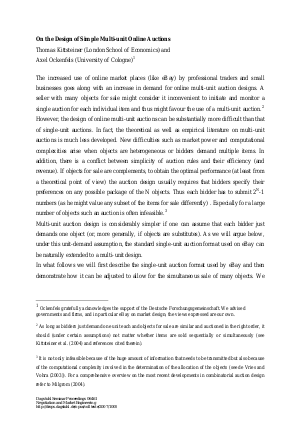On the Design of Simple Multi-unit Online Auctions
Authors Thomas Kittsteiner, Axel Ockenfels
-
Part of:
Volume:
Dagstuhl Seminar Proceedings, Volume 6461
Part of: Series: Dagstuhl Seminar Proceedings (DagSemProc) - License:
 Creative Commons Attribution 4.0 International license
Creative Commons Attribution 4.0 International license
- Publication Date: 2007-05-10
File

PDF
DagSemProc.06461.17.pdf
- Filesize: 50 kB
- 5 pages
Document Identifiers
Subject Classification
Keywords
- Multi-Unit Auctions
- Internet Auctions
- Market Engineering
- eBay
Metrics
- Access Statistics
-
Total Accesses (updated on a weekly basis)
0Document
0Metadata
Abstract
The increased use of online market places (like eBay) by professional traders and small businesses goes along with an increase in demand for online multi-unit auction designs. A seller with many objects for sale might consider it inconvenient to initiate and monitor a single auction for each individual item and thus might favour the use of a multi-unit auction. However, the design of online multi-unit auctions can be substantially more difficult than that of single-unit auctions. In fact, the theoretical as well as empirical literature on multi-unit auctions is much less developed. New difficulties such as market power and computational complexities arise when objects are heterogeneous or bidders demand multiple items. In addition, there is a conflict between simplicity of auction rules and their efficiency (and revenue). If objects for sale are complements, to obtain the optimal performance (at least from a theoretical point of view) the auction design usually requires that bidders specify their preferences on any possible package of the N objects. Thus each bidder has to submit $2^{N}-1$ numbers (as he might value any subset of the items for sale differently) . Especially for a large number of objects such an auction is often infeasible.
Multi-unit auction design is considerably simpler if one can assume that each bidder just demands one object (or, more generally, if objects are substitutes). As we will argue below, under this unit-demand assumption, the standard single-unit auction format used on eBay can be naturally extended to a multi-unit design.
In what follows we will first describe the single-unit auction format used by eBay and then demonstrate how it can be adjusted to allow for the simultaneous sale of many objects. We will discuss some of the drawbacks of this multi-unit design and offer another simple design that can circumvent some of these.
Cite As Get BibTex
Thomas Kittsteiner and Axel Ockenfels. On the Design of Simple Multi-unit Online Auctions. In Negotiation and Market Engineering. Dagstuhl Seminar Proceedings, Volume 6461, Schloss Dagstuhl – Leibniz-Zentrum für Informatik (2007)
https://doi.org/10.4230/DagSemProc.06461.17
BibTex
@InProceedings{kittsteiner_et_al:DagSemProc.06461.17,
author = {Kittsteiner, Thomas and Ockenfels, Axel},
title = {{On the Design of Simple Multi-unit Online Auctions}},
booktitle = {Negotiation and Market Engineering},
series = {Dagstuhl Seminar Proceedings (DagSemProc)},
ISSN = {1862-4405},
year = {2007},
volume = {6461},
editor = {Nick Jennings and Gregory Kersten and Axel Ockenfels and Christof Weinhardt},
publisher = {Schloss Dagstuhl -- Leibniz-Zentrum f{\"u}r Informatik},
address = {Dagstuhl, Germany},
URL = {https://drops.dagstuhl.de/entities/document/10.4230/DagSemProc.06461.17},
URN = {urn:nbn:de:0030-drops-10058},
doi = {10.4230/DagSemProc.06461.17},
annote = {Keywords: Multi-Unit Auctions, Internet Auctions, Market Engineering, eBay}
}
